IN MY OWN WORDS
- PROJECT DOCUMENTATION -
Introduction - Why a museum dedicated to memory?
"It’s like there is a deep gap between the institutional memory, the public narrative of that past, the history taught at school and, indeed, the intimate and private memories - those that emerge with more force when trying to do local history right, including a case study into the broader horizons of global history, dialoguing with it. "
So writes Roberto Bianchi in his blog "Amici di Passato e Presente", in an article dated 31 March 2020 and entitled "The Spanish Flu: Notes on the pandemic of the twentieth century”.
If the Spanish Flu was the disease of the century, the emergency caused by COVID-19, which invested the entire world with incalculable and unpredictable force in 2020, seems to us as the event of the millennium.
We hear repeatedly- and everyone is sure about it - that these last months will 'go down in history'.
Then, as scholars, our critical task becomes to ask ourselves 'How?'.
How will this moment, that we obviously perceive to be significant, be remembered in the future? Will we be able to convey everything we feel now? What will be forgotten?
Bianchi highlights a phenomenon that has always been inherent in human history, and of extraordinary interest for our research: the complex and contradictory relationship existing between history and memory.
History is objective, general, transmitted by influential sources, concerned with big events and major occurrences. Its goal is to transmit the universal tale of the world of the past to future generations. Memory, on the other hand, is individual, sometimes intimate, personal and therefore prone to the risk of deformation, interferences and shortcomings. It is the minimal story of a life, narrated from father to son.
Museums and heritage organisations have always been seen as the main custodians of our past. Their traditional role is commonly perceived to be the preservation of history, the constitution of a formal and “institutional” place to meet, learn and study our past and our historical identity.
But museums are a living thing, and have been knowing an evolution in the last few years. People have become more and more interested not only in the macro-history, but also in the knowledge of the stories of common people, attracted by the possibility to instaurate a personal and emotional bound with them. Furthermore, an higher historical consciousness has made themselves sensible to the possibility to tell their own story. Thus, museums (and in particular, as we will see, virtual museums) can also host the other kind of history: the individual, private, micro-history that is part of the universal one like a mosaic tile.
In the “dispute” between macro-history and individual micro-memories we have chosen to privilege the latter, by telling the collective experience of the COVID-19 emergency, without concealing its intimate dimension nor forgetting its limits: its individualistic nature and its inevitable belonging to a larger whole. It’s often said that history is made by those who live it. Let's also tell it this way.
Ideation and Concepts
The idea of a museum dedicated to the COVID-19 emergency period came to us from the natural exchanging of experiences during the pandemic. We noticed that people have produced memories of their lives during this particularly difficult historical moment and feel now the need to communicate their personal experiences.
The COVID-19 emergency wasn’t only - although the hospital crysis was tragic and devastating - a physical emergency, but also a psychological one. All the people in the world were requested to social distance themselves, to avoid contacts and to remain home. Due to the quarantine, the space where things could be exchange became the web: the online environment has been the only way to meet other people and to make people feel - closed in their own home - part of something. It was the only way in which people could stay together.
Because of this, the idea of a virtual museum able to collect all these witnesses, eager to be shared, came to us naturally. We decided to build a unique virtual place for all the uncommon stories of common people, in the form of a museum whose traditional role is to preserve, interpret and communicate the history of a whole population that has found itself to share an unpredictable moment in history.
Purpose
Conceptual map
Why did we choose this idea?
The main aim of this project coincides with the traditional museum purposes: preserving the authenticity of this particular historical moment, in order to convey it to the future generation. But this fascinating challenge and this innovative scope lie in the way in which this authenticity is realized and told. Indeed, it is a museum "built from below", aimed at housing common people experiences and contents realized in a moment of crysis.
This pandemic situation is maybe the first time in human history in which no one can be called a simple spectator: we thus wanted to make a step back and allow everyone to tell their own story.
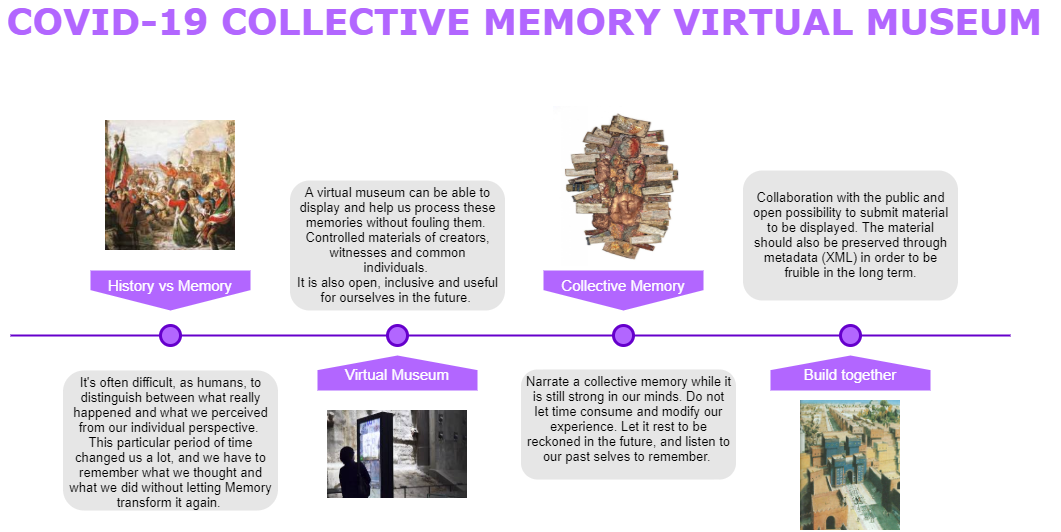
Conceptual map of the project, realized with draw.io
We wanted to catch someway the different experiences and perspectives of people living a situation which never happened before at this scale and in this modality. Everyone of us has lived this period in a different way, but we have all shared similar feelings and emotions, which became the guides of our museum, the fil rouge of this collective diary. History and memory are related concepts but at the same time show contradictions: while history is a narration of events through an objective point of view, memory is the personal, sometimes biased, experience of an individual through individual eyes, personal “world vision” and sentimental involvement. It is not inherently wrong to show and speak about memories: the important misstep to avoid is to not present it as actual history or use it as the only source for the historical narration of an event. What we want for our visitors is to experience and think about their own memories by getting in touch with others similar experiences. Our last hope is for visitors to leave the museum with a new sense of empathy and relie.
Feasibility study
Requirements
Once we had clear in mind what we wanted to realize, we needed to think about how to actually realize it.
First of all, we need people actually engaging in the virtual museum data population. To do that, the museum itself requires a self-advertisement system able to make contact with common people and invite them to collaborate. The advertisement should take place inside institutional sites that may share common interests and, of course, in social media platforms. The project should also state clear rules that do not excessively limit the participation in the site but at the same time avoid a mass of interactions not easily manageable, at least in the short term. Also we needed to state the related data protection policies (since the project relies on a collective effort of individuals) and to create a reliable and trustful system for users to interact.
Last but not least the project should find (possibly) public funding for sustaining the project in the long term both on the managing and advertisement sides or create a fully sustainable funding through voluntary donations of visitors.-
Needed input: what we need in order to realize and populate our museum
- Displayed contents (original photos, videos, texts) with related descriptions provided by the users or by the managers;
- Long-term preservation metadata (XML document validated through Dublin Core metadata)
-
Desired output: what result we expect
- A virtual museum with its structure composed by a number of rooms, each dedicated to a certain theme the memories may follow
- A user submitting and content sharing system
- An extensive About section and a GDPR explanation
- Few initial examples for other people who want to participate.
In order to populate our museum, we ask users for stories or memories that are someway involved with the COVID-19, the quarantine, or the consequences of it. We are not requesting any specific method, structure or material for it, still we would prefer for an image plus textual schema, since we think it is best suited for our purposes: the stillness in time of the image that shows without telling united to the power of words that may direct a more emotional, sympathetic and precise message.
Furthermore, each of the memory should have been described by long-term preservation suitable metadata. So, the content requirements for our museum could have been summarized as:
In addition, we needed a concrete place where to store and present our museum content. Thanks to its development simplicity and reception immediacy, we chose to realize our virtual museum in the form of a website. Indeed, this latter format would have allowed us to exploit the online environment disponibility of space and at the same time to reach as many users as possible.
Starting from this material, we tried to visualize the desired output. The final result should have been a virtual museum able to give to the visitors the possibility to freely surf it in its entirety by choosing the path he or she would have preferred, attracted and driven by the content themselves. Also, the essence of the museum would have relied on the user interaction and contribution through the realization and share of their personal content. The museal result should have been an online website representing:
Further, data would have been textual and/or multimedial, with related XML data to preserve and organize the submitted material. For privacy and safety reasons the XML files will not be made public unless under request, and through authorization from the author.
Content
Museum content and organization
- Stories of Love
- Stories of Pain
- Stories of Solidarity
- Stories of Celebration
- Stories of Effort
- Memorial
Selection criteria
Metadata
The content of the museum revolves around the COVID-19 emergency. We decided to dedicate only a small initial section to the explanation of the historical data: dates, numerical data and a general introduction to the whole situation. An interactive daily updated map realized through Flourish (app.flourish.studio) situated in the first page of the website perfectly fulfilled this purpose. We consciously avoided a single-voice narration, preferring to let it rise and be drawn by the diversity and heterogeneity of the memories and stories shared by the users.
The content displayed in the museum’s rooms is fully provided by the users that answer to the call for collaboration.
We received soon the first testimonies realized by people representing how everyone has lived this period in a different way. Some of them were something the users produced autonomously during the quarantine; some other were explicitly asked by us to people we knew experienced something meaningful related to the emergency; some other again were instead realized by users specifically for the museum, representing the possibility for them to relaborate their experience and give form to their feelings.
Already in this first moments of collection of the museum content, we can say we are satisfied with the type of testimonies we are receiving. Each story has its intrinsic emotional and personal value, and in addition they already present a great variety: we have stories of workers, students, sisters, lovers and mothers. Some of them lived the quarantine in solitude, others rediscovered the joy of the closest affections, still others had to face this emergency while they were on the other side of the world: Tokyo, Honduras, Armenia, Turkey...
After having gathered the first testimonies, we procedeed to individuate a hidden aspect among them. We noticed that, even if we have experienced this period in different ways, we have all shared a seesaw of feelings. We realized that feelings should have been the fil rouge in the representation of the memory of this time. And feelings were also a good way for organizing efficiently the material, and to show how different experiences could have had a similar sentimental outcome.
The main structure of our museum is based on rooms able to classify contents in six different macro-areas related to a feeling or a predominant theme:
In the first five of them, the main content of the museum is displayed. Each of the item is individuated into the respective room by a photography, an introducturoy caption and the identifying data of the author.
When clicking on the photography displayed in the room, the user can access its actual content in the dedicated page. Here, each item is shown in the way that best represents its unicity: it can be an image or a collection of images, a video, an audio-track or a simple text. Then, a description provided by the user explains the meaning of the testimony. The textual description is given in its original language (the one provided by the author) and in an English translation. Finally, each memory presents the "signature" of its author with the name of the author, the date and place where it was created.
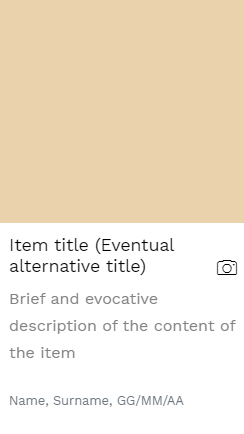
Schema of an item in the collection
Also, we decided to classify the huge variety of items through the use of graphic icons indicating whether they are:
Legenda of item classification icons
Furthermore, we decided to reserve a specific room to stories that unluckily could be narrated only by someone else since the protagonists of them died during this time. A Memorial was thus dedicated to remember all those people that passed away in this tragic situation which didn’t give them the possibility to say goodbye to their loved ones.
This very particular section represented for us the possibility to express strong but at the same time delicate feelings born from this situation. If in the first five rooms of the museum we showed how life went on during the quarantine and the emergency, here we should have represented instead all the lives that were taken away from the virus. We decided to do that in the most powerful and discreet way we were able to: by showing the bare and raw data of the sum of the lives that continued - and still continue - to be broken by the virus, in order to represent through a visual and temporal data the enormous extent of this tragedy and arouse in the spectator the same feelings of anguish, expectation, desire that all this would end. But at the same time, we wanted to underline the importance of considering not only sterile numbers in these data, but of recognizing in them people, fathers, brothers and children who are no longer there. To recognize stories that can now only be told by someone else. To recognize memories that could have been added to ours if only they had made it.
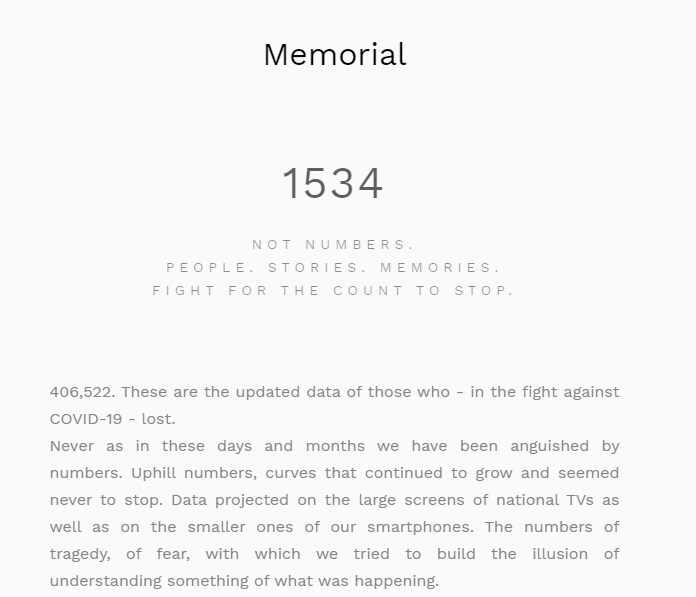
A snapshot of the memorial section of the museum
We are also well conscious that this memorial strays a bit away from the strict museological function and purposes, still we think it someway serves society.
The criteria for inclusion in the museum are various and not easily grouped in a singular paragraph. The selection heavily depends on the content of the contributions. Since IMOW cannot avoid talking about tragic or adult-related issues, it will include tags (trigger and content warnings) that indicate the specific theme of an element. The museum a priori rejects content that is illegal in itself or that is related with illegal content according to Italian and European laws. The museum rejects any content that incites violence or makes use of discriminatory language, that has fascism apologetic content, that spreads fake news. Any refusal is in addition linked to adequacy within the ethical lines of the museum itself.
Every item of the museum collection is described by a set of metadata for its preservation in the long term and for the possibility to reuse the items in other exhibitions. The items’ metadata are stored in a XML document validated through the Dublin Core vocabulary. XML, thanks to its device-independent and system-independent essence, is the perfect mean to reach an effective interoperability and exchangeability of data. Dublin Core validation allowed us to express the most important, essential information related to each item, while still maintaining a light and easily manageable structure of the description. In particular, we pay a special attention to these elements:
| Title | title of the item as it appears in the website |
|---|---|
| Alternative Title | the alternative title of the item if it has one |
| Creator | the website itself, that publishes the user's items |
| Publisher | the website itself, that publishes the user's items |
| Abstract | a very short description of the item and its themes |
| Right | indications about the right management of the website |
We chose this set of really self-explanatory tags both for their simplicity and for the very nature of the contributions, for which we do not expect further information to be needed. In the event that new contributions prove otherwise, we will update this section.

Example of an XML document with the metadata related to an item of the collection
Multimedia score
The user enters the museum and finds themselves inside the "reception" of the museum, the Homepage. The user enters and is encouraged to read the short paragraphs at the top of the page that trace a simple description of the project. Also, a simple thread with steps shows how the museum actually works. The following is a basic example of how an user could navigate inside the rooms:
- After the user has entered, he can choose one of the 6 rooms of the museum. Each room is structured with a grid view of various memories.
- The user can choose one of them, and is redirected to the individual memory.
- The user can choose to visualize the next story or to select another story from similar ones inside the room or in other rommes or go back to the home.
- Shared experiences and thoughts are seen by the user, who experiences a sense of solidarity, empathy, and (hopefully) feels less alone in their personal experience.
Hopefully, after the user has visited the museum, they decide to turn themselves into a contributor. In this case:
- The user gives a textual or multimedial shape to its own memory, this way elaborating it in a structured way.
- The user submits their material (multimedia, text and so on) to the IMOW managers, that evaluate and eventually accept the contribute.
- The user waits and receives an email as soon as the contribute has been uploaded.
Otherwise:
- After their "stay", the user can give feedback about the museum.
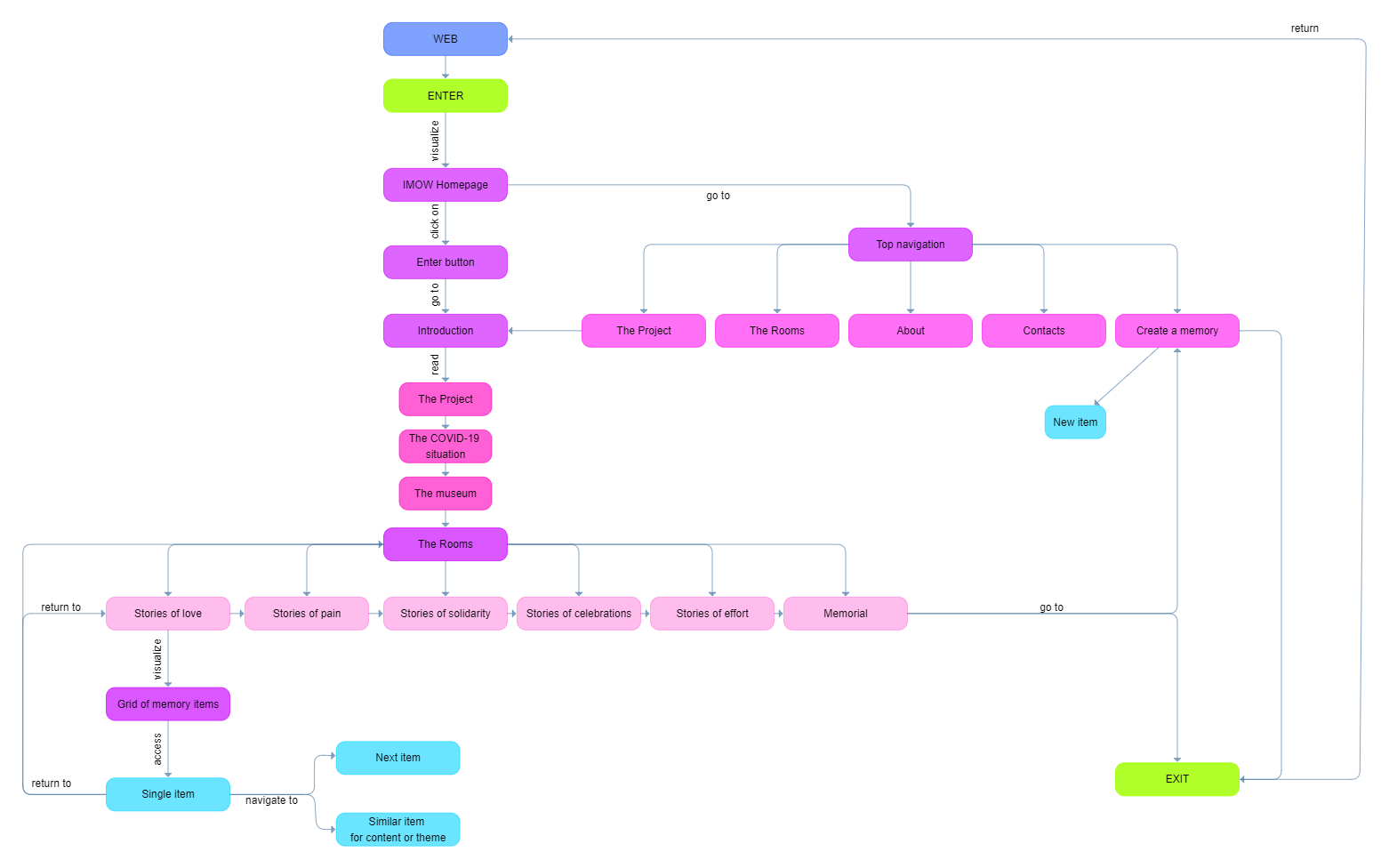
Graphical example of the multimedia score of the project, realized with Yed
Click here to see the schema.
Where do we stand as a museum?
Following the proposed taxonomy of S. Caraceni (2015) this museum may be considered a Virtual Museum of "F" category.
| Need | Complex Museum Identity |
|---|---|
| Interaction | Open |
| Space | Open |
| Content | Digital videos, texts, audios (spoken words, music), georeferenced materials |
| Virtual/Real | Virtual |
| User Contributions | Allowed (required) |
IMOW is an open platform in which visitors both explore and contribute to the content. It is an open space, only organized throughvirtual "rooms". All the material is born virtual, in the meaning that it has no physical counterpart. It has no related physical gallery nor exhibition.
IMOW is a virtual gallery that doesn’t necessarily stand in the common perception of museum. It is not an experimental museum, since the gallery, the rooms and the contribution system are familiar enough to both the public and the scholars. IMOW has an hybrid identity between a museum and a public diary. Interaction, at least for the initial phase after basic development, is limited to contribution and approachability of the IMOW team. It has no strictly guided itinerary apart from the "related content" system. IMOW is freely browsable by any user without subscription to the museum.
Design and developement schema
Graphic User Interface
Usability and accessability
We have paid particular attention to the site's GUI, being it the main way of user interaction along the museum.
In addition to the explanatory sections, created in the most user-friendly way possible, we have decided to create an entire section dedicated to the "rooms" of the museum. The same definition of this section wants to underline how we tried to transliterate the most traditional structure of a museum onto a website: a path of rooms and themes, through and in which the user can access the real objects of the collection.
Even the testimonies themselves - our "collectibles" - are designed starting from the traditional experience of a museum visit. Their visualization and presentation are reminiscent of paintings hanging on the walls of a gallery or of objects placed in the display cases of a museum: each of them has a title, an author, a date and a small introductory caption.
The website format for the realization of our virtual museum certainly has many advantages. It is an open, free space, easily accessible by anyone with an internet connection. Thanks to its ease of use, it can truly be a universal place, capable of being reached by everyone.
However, it also has its challenges. The first is related precisely to accessibility: to the user's ability to access the site and its multimedia contents regardless of the type of device, connection or personal skills that he has. For this reason we have tried to make the site as responsive as possible through the joint use of CSS stylesheets and Bootstrap tools, so that it can be consulted on any type of device. Furthermore, the content of each multimedia object is described by a specific HTML attribute, (alt = ""), so that the essence of each item can still be understood by everyone, even where the device or browser does not allow access to its content.
The usability of the site was another aspect to which we paid particular attention. We tried to make the site as easy to navigate as possible, creating a guide among its contents while leaving the user free to access any item that attracted his attention, without this impoverishing the visit to the museum. Also, the real challenge was to make a visit really similar to a traditional the museum visit on a website. The development of a user-friendly interface therefore had to be combined with the specific identity of a site which is also a museum.
Furthermore, since the user's collaboration is an essential and founding part of the museum, it has also been important to be able to establish a direct relationship with the visitor, and to call him to collaborate and interact. For this we have created a special section in which the user can easily create, guided by the indications of the site, his "memory", his content to be displayed inside the museum.
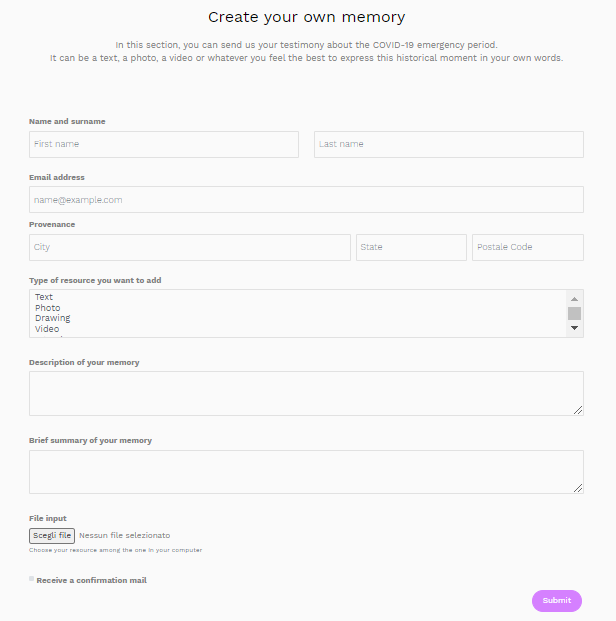
The "Create your memory" section where the user can contribute to populate the museum content.
Finally, particular attention was paid to the possibility of preserving the museum's data and making it interoperable and shareable within a wider - museum and non - museum network. This was accomplished by the creation of XML documents validated in DC and linked in the header of each item.
Presentation of the content, enhancement of the experience, interaction with the user and data preservation were therefore the four pillars of our work and the four starting points from which to expand and improve it.
Ethics and Rules
These ethical guidelines are in their entirety respected by this museum management team. These ethical guidelines are based on the ICOM Ethical Guidelines, the UNESCO Ethical Principles for Intangible Cultural Heritage and the EU General Data Protection Regulation. The parts referred and regarded by the IMOW Deontology are:
- the IMOW Virtual Museum;
- IMOW Team: namely Ciambriello Virginia, Silva Elisa, Schimmenti Andrea;
- IMOW contributors;
- IMOW contributions;
- IMOW visitors;
IMOW roles:
- Preserves the memories of the contributors in a safe, inclusive space (preservation through durable m etadata formats);
- Interprets the memories through a precise conceptual and virtual framework and by looking at them in a larger web of connections;
- Promotes itself as a valuable heritage keeper for human memories.
IMOW Duty Ethics:
- Given that IMOW couldn’t exist without its contributions, it will be enjoyable by visitors absolutely free of charge for the whole duration of its existence.
- No contribution (any intangible cultural artifact) inside IMOW will ever be marketed or used for profiting reasons, individually or collectively.
- No contribution will be held inside IMOW for other purposes than the benefit of society.
- No contribution inside IMOW is intended to cause physical or psychological harm to individuals (including contributors and visitors). Each submitted contribution is previously checked and, if respectful of both the contributor and the visitors, published. Any sensible content will be underlined with a specific trigger warning related to the contribution content.
- Every contributor has the right to retreat its contribution and have it completely removed (both from IMOW and from the metadata database managed by the IMOW team).
- IMOW exercises control to avoid disclosing sensitive personal or related information and other confidential matters when contributions are made available to the public.
- No intangible cultural artifact will be held inside IMOW without a precise and trusted provenance. IMOW will not trust contributions of dubious origin and detains the right of rejecting such contributions. If a visitor, contributor or user suspects or has proof that any of the displayed material should not be displayed because of lack of personal permission, copyright issues, unauthorized share of information or any other reasonable motivation, they must contact the IMOW Team in order to solve the issue. IMOW will also independently check, in case of suspicion, the provenance of already displayed material and ask the original contributor for additional proof.
- IMOW will have professional and diligent care of displaying the contributions in a respectable way, especially in those cases where the contributions possess sensitive meanings. In the aforementioned cases, IMOW has the right to implement content changes, subject to the contributor’s approval in full compliance with its creative rights. Any change made by the IMOW team does not change the authorship of the contribution in any way.
- IMOW has professional and diligent care of displaying well-founded, accurate and appropriate information. IMOW avoids displaying or otherwise using informations of questionable origin or lacking provenance, e. g. when providing information, if needed, about the Covid-19 pandemic.
- IMOW operates in any part of their management in a professional manner, with respect to laws and ethics about the administration of intangible artifacts.
GDPR declaration
You can find every about our General Data Protection Rules here: IMOW GDPR.
Further Development and Maintenance Issues
We feel that IMOW is only at it beginning. As a newly born project, it has only a well-defined structure, which is waiting to be populated by the contents of all those users who decide to share their memories inside the museum.
A first objective that we set ourselves is therefore to enrich the museum with as many contents as possible, to give the visitor a truly complete and varied vision of this historical moment - possible only if we were able to reach people who have lived different experiences. Therefore it will be necessary from now on to publicize the project and make sure that as many users as possible are encouraged to participate.
Further developments for the virtual museum revolve mostly around maintenance, devolopment of higher-level interaction, management of the submitted data. We look forward implementing a registration systems for users and a tool for automatically insert new memories/items inside the rooms, with just a supervisor verification before making them public. Further possibilities include, depending on the user interaction, a comment/feedback from the users section (just like in physical museums), counters of how many people visited the site, a research system and social media integration for shareability.
Bibliography
- Reference texts
- Roberto Bianchi, The Spanish Flu: Notes on the pandemic of the twentieth century, 2020 in the blog Amici di Passato e Presente <https://amicidipassatoepresente.wordpress.com/2020/03/31/la-spagnola-appunti-sulla-pandemia-del-novecento-roberto-bianchi/>;
- Caraceni, S. (2015). Designing a taxonomy for virtual museums <https://collections.plymouth.ac.uk/handle/10026.1/9915>;
- ICOM, Key concept of museology, <http://www.icom-italia.org/wp-content/uploads/2018/02/ICOMItalia.KeyconceptsofMuseology.Pubblicazioni.2010.pdf>;
- ICOM, ICOM code of ethics, <https://cimam.org/resources-publications/icom-code-ethics/<>
- Software references and tools
- For the realization of the website:
- HTML 5
- CSS 3
- Bootstrap
- Javascript
- Free template from <https://www.free-css.com/free-css-templates>
- For the tools used in the website:
- Interactive updated map with COVID-19 data realized with Fluorish Studio - Data Visualization & Storytelling <https://flourish.studio/>
- Conceptual map realized with Draw.io - Diagrams.net Flowchart Marker and Online Diagram Software <https://app.diagrams.net/>
- Multimedia score schema realized with yEd Graph Editor <https://www.yworks.com/products/yed>
Enter the museum